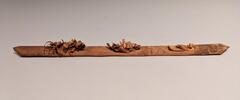22 UMMA Objects
22 UMMA Objects
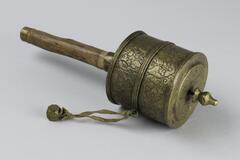
Tibetan (Tibetan (culture or style))
Prayer Wheel (Mani Wheel)
1833 – 1932
Gift of the Estate of Maxine W. Kunstadter in memory of Sigmund Kunstadter, Class of 1922
1983/1.423
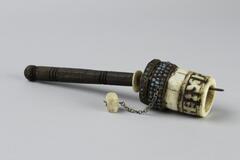
Tibetan (Tibetan (culture or style))
Prayer Wheel (Mani Wheel)
1833 – 1932
Gift of the Estate of Maxine W. Kunstadter in memory of Sigmund Kunstadter, Class of 1922
1983/1.424
![A glazed and speckled porcelain offering dish for an altar. The base is a wide decorated cylinder which tapers sharply into a narrow top. The base supports a wide, shallow bowl.<br />
<br />
This ritual dish was produced at a regional kiln. It is a low-quality object with a rough texture, made from the clay mixed with sand, contaminated with many impurities on the tray. Its glaze is dark with blue-green tints, giving the vessel the appearance of celadon. Its foot has an octagonal cross-section.<br />
[Korean Collection, University of Michigan Museum of Art (2014) p.200] A glazed and speckled porcelain offering dish for an altar. The base is a wide decorated cylinder which tapers sharply into a narrow top. The base supports a wide, shallow bowl.<br />
<br />
This ritual dish was produced at a regional kiln. It is a low-quality object with a rough texture, made from the clay mixed with sand, contaminated with many impurities on the tray. Its glaze is dark with blue-green tints, giving the vessel the appearance of celadon. Its foot has an octagonal cross-section.<br />
[Korean Collection, University of Michigan Museum of Art (2014) p.200]](/media/W1siZiIsIjIwMjIvMDkvMjQvNm45anZucHNldV9kZWZhdWx0LmpwZyJdLFsicCIsInRodW1iIiwiMjQweDIwMCJdXQ?sha=ccdbeadfd710d294)
Korean (Korean (culture or style))
Altar Dish
1850 – 1899
Gift of Ok Ja Chang and the Chang Family
2009/2.47
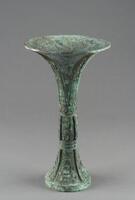
Chinese (Chinese (culture or style))
Gu (libation goblet, one of a pair with 1948/1.118)
8700 BCE
Bequest of Margaret Watson Parker
1948/1.117
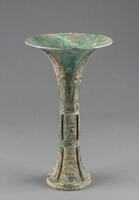
Chinese (Chinese (culture or style))
Gu (libation goblet, one of a pair with 1948/1.117)
8700 BCE
Bequest of Margaret Watson Parker
1948/1.118
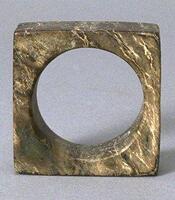
Chinese (Chinese (culture or style))
Jade cong cylinder with low relief design
8700 BCE
Gift of the Estate of Agnes E. Meyer
1971/2.102
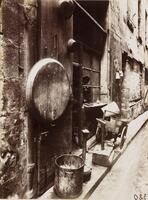
Eugène Atget (French (culture or style))
Un Coin de la Rue Reynie
1912
Museum Purchase made possible by the Friends of the Museum of Art
1971/2.140
Loading…
![This is a ritual dish assumed to have been produced at the private kiln near Bunwon-ri to supply the general pulic. The dish is deeper than the most other ritual vessels produced at the official court kilns, while the diameter of the mouth is small in relation to the maximum diameter of the foot. The clay and glaze are well fused. However, the the glazed surface has darkened due to the contamination by large amounts of ash. The base of the foot shows many traces of coarse sand supports. This type of ritual vessel with high foot is unique and simple in form that it was one of the Joseon ceramic vessels that was widely sought after by Western collectors.<br />
[Korean Collection, University of Michigan Museum of Art (2014) p.197] This is a ritual dish assumed to have been produced at the private kiln near Bunwon-ri to supply the general pulic. The dish is deeper than the most other ritual vessels produced at the official court kilns, while the diameter of the mouth is small in relation to the maximum diameter of the foot. The clay and glaze are well fused. However, the the glazed surface has darkened due to the contamination by large amounts of ash. The base of the foot shows many traces of coarse sand supports. This type of ritual vessel with high foot is unique and simple in form that it was one of the Joseon ceramic vessels that was widely sought after by Western collectors.<br />
[Korean Collection, University of Michigan Museum of Art (2014) p.197]](/media/W1siZiIsIjIwMjIvMDkvMjQvMnJ2dzIwdHZ0a19kZWZhdWx0LmpwZyJdLFsicCIsInRodW1iIiwiMjQweDIwMCJdXQ?sha=38d51954f86a9ca4)


